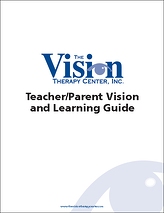
A success story submitted by Carole Passarelli.
I discovered the field of developmental vision therapy as a treatment modality for my 41-year old autistic daughter quite by chance. When I re-read the autobiographical books by Donna Williams (a high functioning person with autism), I was struck this time by the breakthrough she experienced with vision therapy using Irlen Lenses. She described how her world started to make more sense. This led me to research and seek a potential provider of therapy for Marie. This search led me to Dr. Kellye Knueppel at The Vision Therapy Center.I read books: “Seeing Through New Eyes” by Melvin Kaplan and “Envisioning a Bright Future” by Patricia Lerner. I learned that vision therapy (VT) involves the brain as well as the eyes, and many developmentally disabled people have neurological problems that prevent them from correctly perceiving what they see. I hoped that by integrating visual processes with other sensory systems, we could help her achieve a higher level of performance that would impact her behavior, communication, learning and social interactions. Since Marie had outstanding success with occupational therapy sensory integration therapy to calm and ground her, I was eager to have her assessed for VT. I conceptualized it as a type of physical therapy for the brain through the eyes.
The initial assessment did reveal moderate to severe problems with eye teaming, ocular motor dysfunction, and double vision. I learned that these correctable dysfunctions were creating sensory overload and spatial disorientation and disorganization, and was told the prognosis for a functional cure was very good. I was hopeful that these corrections would help Marie’s world to expand; that she would begin to better comprehend reading, communicate better, and improve her social and vocational life.
Marie looked forward to her weekly therapy sessions with Brian, and worked hard on her homework activities. She especially liked the daily viewing of the syntonics lamp which seemed to relax her.
We noticed subtle changes and improvement within the first few months of treatment. She seemed generally more mellow and content, with fewer “blips” in her behavior. By the end of treatment, testing showed that she had made significant improvement in eye teaming and eye tracking skills. Since Marie is unable to describe in words how she perceives these changes taking place in her experience of the world, I can only give subjective observation: We notice that she seems less “driven,” better able to stop compulsive activities; she is trying to verbally express herself more; her reading seems less “mechanical” and there is more expressiveness in her voice inflections. She seems more aware of her surroundings, has more purposeful visual attention, and is less rigid and defensive in her posture and gait. She is also more attentive, and less disturbed by distractions.
I am encouraged by these observations, and my hope is that the improvements will continue to evolve over time. I hope that we are witnessing another piece of the autism puzzle fall into place, and that Marie will continue to emerge to her full potential!
I am very grateful for the hope this therapy has given us!
This is a success story submitted directly from a client of The Vision Therapy Center. This is a testimonial, and the person submitting the story was not compensated in any way for their contribution.
Click here to submit your own vision therapy success story and tell how The Vision Therapy Center helped you.
 Learn how undetected vision problems can impact a child's ability to learn. Download your free Vision and Learning Guide.
Learn how undetected vision problems can impact a child's ability to learn. Download your free Vision and Learning Guide.
